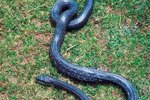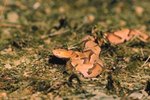
Ringneck snakes (Diadophis punctatus) are narrow-bodied family Colubridae reptiles that have vast geographic scopes all throughout North America's central and eastern portions, from Mexico to the United States and Canada. Ringneck snakes' naming comes from the paler orange or yellow neckbands that are situated directly on the backs of most of their heads.
About Ringneck Snakes
Ringneck snakes' upper sides are usually grayish-blue, grayish-green or pale brown in coloration. The lower portions of their bodies, however, are yellow to orange. In many cases, these bright colors are deepest just below the tails, which can sometimes even take on red appearances. Some of these reptiles display dark blotting over their stomach regions. Fully mature males are smaller than fully mature females, although the females possess smaller tails, commensurately speaking. Ringneck snakes generally achieve lengths of between 10 and 15 inches. Habitat-wise, they gravitate toward grasslands, foothills, woodlands, hillsides, floodplains, valleys and forests. Damp environments are often a preference for the species. They frequently seek out areas that have plenty of suitable hiding spots, whether tree bark, stones or logs. The reproductive season for ringneck snakes occurs in the autumn or spring months. Their clutches are generally made up of between three and 10 young. After egg laying, the youngsters do not receive any parental assistance. Both sexes typically gain reproductive abilities once they are around 3 years old.
Poisonous
Individuals of this species are totally innocuous to people. However, they are indeed slightly venomous. Ringneck snakes' saliva contains moderate venom, which they utilize to control their prey animals. Trapped ringneck snakes frequently salivate out of the sides of their mouth -- perhaps because of giving off venom.
Venom With Prey
Ringneck snakes' prey animals are frogs, lizards, slugs, tiny salamanders, young snakes, bugs and earthworms. A lot of what these predominantly diurnal snakes consume relies on what they can track down around them. Ringneck snakes give off their venom through the massive teeth that are situated in their upper jaws. They use this venom, in conjunction with constriction, to paralyze their prey and go in to eat.
Predators
Ringneck snakes use venom to help paralyze prey animals, but they are often sought after as prey themselves. Some notable predators of the rather clandestine species are eastern screech owls, Virginia opossums, blue racers, northern coral snakes and wild hogs. In threatening situations, some ringneck snakes often twist their tails and elevate them while pointing them directly at the other parties -- a handy "back off" signal.
References
- Idaho Museum of Natural History: Diadophis Punctuatus
- The IUCN Red List of Threatened Species: Diadophis Punctuatus
- University of Michigan Animal Diversity Web: Diadophis Punctuatus
- Savannah River Ecology Laboratory: Ringneck Snake
- Washington Department of Natural Resources: Diadophis Punctuatus
- University of Michigan BioKIDS: Ring-necked Snake
- Amphibians and Reptiles of Georgia; John B. Jensen
Photo Credits
-
George Doyle/Stockbyte/Getty Images




